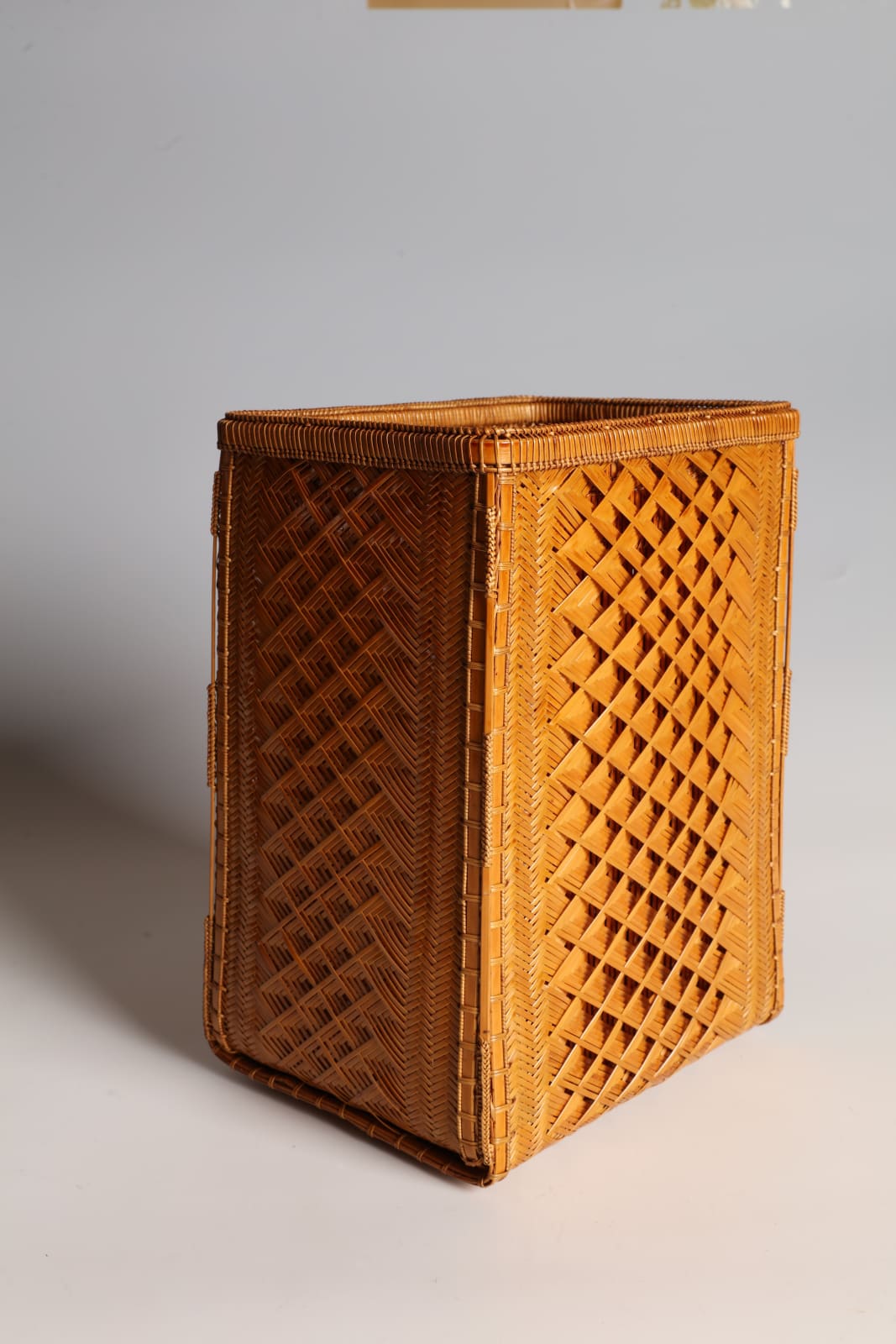Maeda Chikubōsai II
Rectangular Flower Basket with Multilayered Openwork Design, 1980s
Bamboo and rattan
Size 11¾ x 8¾ x 7 (30 x 22.5 x 17.5 cm)
T-5039
Of shiratake (leached or whitened bamboo) and rattan, the exterior entirely formed from multilayered ajiro-ami (twill plaiting), the interior of senjōgumi (parallel-line construction) secured by twining, the corners and rim...
Of shiratake (leached or whitened bamboo) and rattan, the exterior entirely formed from multilayered ajiro-ami (twill plaiting), the interior of senjōgumi (parallel-line construction) secured by twining, the corners and rim secured with multiple knots; complete with a cylindrical brown-lacquered bamboo otoshi (water container)
Signed underneath with incised characters: Chikubōsai tsukuru (Made by Chikubōsai)
Comes with the original fitted wood tomobako storage box inscribed outside: Jū-ami katahanakago (Rectangular Flower Basket with Layered Plaiting); signed inside Chikubōsai tsukuru (Made by Chikubōsai) and sealed Chikubōsai; accompanied by a presentation printed biography
Born in Sakai City, Osaka, Maeda Chikubōsai II was immersed in the world of bamboo art from an early age, studying first under his father, the renowned bamboo artist Chikubōsai I, then from 1936 deepening his training under Yamamoto Chikuryōsai I, another prominent figure in the field. By 1941, he had established himself as an independent artist, developing a distinctive style that blended classical techniques with a refined modernist sensibility. In 1950, he formally succeeded to the name Chikubōsai.
Works from Maeda Chikubōsai II’s mature period are admired for their complex, layered surfaces, as seen in this technically very ambitious basket executed in sixfold twill plaiting creating an extraordinary sense of depth. The earliest datable basket by Chikubōsai II in this challenging technique, in the Naej Collection (shortly to be made available online), has a storage box signed by the artist and stating that it was exhibited at the first Nihon Gendai Kōgei Ten (Japan Contemporary Craft Exhibition) held in 1962). The printed biography accompanying the present basket, however, allows us to date it somewhat later in Chikubōsai II’s career to the years 1982–1995 since it notes his 1982 commendation from the Governor of his native Osaka Prefecture but stops short of his 1995 designation as a Holder of an Important Intangible Cultural Property (“Living National Treasure”). A similar basket to the Naej example is in the Metropolitan Museum of Art (promised gift of Diane and Arthur Abbey (see Monika Bincsik, “Japanese Bamboo Art: The Abbey Collection,” The Metropolitan Museum of Art Bulletin, Spring 2017, pl. 42).
Signed underneath with incised characters: Chikubōsai tsukuru (Made by Chikubōsai)
Comes with the original fitted wood tomobako storage box inscribed outside: Jū-ami katahanakago (Rectangular Flower Basket with Layered Plaiting); signed inside Chikubōsai tsukuru (Made by Chikubōsai) and sealed Chikubōsai; accompanied by a presentation printed biography
Born in Sakai City, Osaka, Maeda Chikubōsai II was immersed in the world of bamboo art from an early age, studying first under his father, the renowned bamboo artist Chikubōsai I, then from 1936 deepening his training under Yamamoto Chikuryōsai I, another prominent figure in the field. By 1941, he had established himself as an independent artist, developing a distinctive style that blended classical techniques with a refined modernist sensibility. In 1950, he formally succeeded to the name Chikubōsai.
Works from Maeda Chikubōsai II’s mature period are admired for their complex, layered surfaces, as seen in this technically very ambitious basket executed in sixfold twill plaiting creating an extraordinary sense of depth. The earliest datable basket by Chikubōsai II in this challenging technique, in the Naej Collection (shortly to be made available online), has a storage box signed by the artist and stating that it was exhibited at the first Nihon Gendai Kōgei Ten (Japan Contemporary Craft Exhibition) held in 1962). The printed biography accompanying the present basket, however, allows us to date it somewhat later in Chikubōsai II’s career to the years 1982–1995 since it notes his 1982 commendation from the Governor of his native Osaka Prefecture but stops short of his 1995 designation as a Holder of an Important Intangible Cultural Property (“Living National Treasure”). A similar basket to the Naej example is in the Metropolitan Museum of Art (promised gift of Diane and Arthur Abbey (see Monika Bincsik, “Japanese Bamboo Art: The Abbey Collection,” The Metropolitan Museum of Art Bulletin, Spring 2017, pl. 42).
